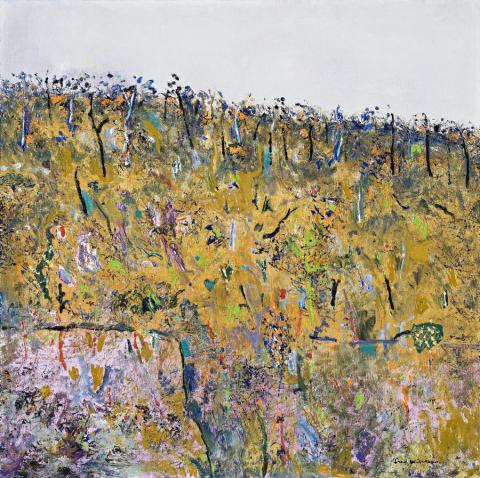BLACKWOOD WATTLE, 1976
Fred Williams
oil on canvas
101.5 x 101.5 cm
signed lower right: Fred Williams
Rudy Komon Gallery, Sydney (label attached verso)
Private collection, Sydney
Deutscher~Menzies, Melbourne, 2 September 2003, lot 46
Art Galleries Schubert, Queensland (label attached verso)
Private collection, Queensland
It was the midwinter of 1969 when Fred Williams began painting wattle - at his friend, Clifton Pugh's place 'Dunmoochin', near Cottles Bridge. Although only just northeast of Melbourne, Williams did not return to the subject again until the winter of 1974. Leaving Melbourne with his artist friend Fraser Fair for a day's painting, they drove to Cottles Bridge, Williams's enthusiasm for the subject recorded in his diary entry for 24 July. 'Fraser here at 9.15 & we set off for a spot of "Wattle"... We go out through Panton Hill - don't find a spot that is "private" enough - finally get on to Cliff's Rd at Cottlesbridge [sic] just below his house... It was a superb spot and a delight to paint the Wattles in their [natural] surrounds.'1 The immediate paintings included the colourful series Acacias I to III of 1974 and the large Landscape with Acacias Diptych, formerly in the collection of R. C. Crebbin. Noted for their profusion of motifs and colours - pinks, blues and golden yellows - they show Williams's widening interest in colour and the effective acceptance of yellow into his palette.2 Wattle featured seven times in his work during the following year, the most significant being the richly textured and colourful The Botanist's Garden 1975. There is an interesting affinity between The Botanist's Garden and Blackwood Wattle 1976. Each shares the same rainbow palette and are of the same size. It is likely that both were painted at St Andrews. Not too far from Pugh's place, Williams had commented on its' remarkable [collection] of Wattles and shrubs...'3 The tangle of trees and undergrowth speaks of the overgrown garden, The Botanist's Garden providing a close up view and Blackwood Wattle a more panoramic spread filled with light, airy atmosphere. The paint almost dances across the canvas in its free handling, the palette beguiling through enticing mauves, with touches of purples, blues, aquas, lemon greens, and reds across the field of yellow ochre under paint. The yellow of the wattle is given extra vibrancy by being contrasted against the black of its native trunks. The whole painting breathes of the artist's involvement in the landscape, celebrating wattle as the harbinger of spring, the season of regeneration.
1. Fred Williams quoted in Mollison, J., A Singular Vision: The Art of Fred Williams, Australian National Gallery, Canberra, 1989, pp. 174-5
2. Mollison, op. cit., p. 174
3. Ibid., p. 178, diary entry for 14 August 1975, and conversation with Lyn Williams 23 July 2003
DAVID THOMAS
